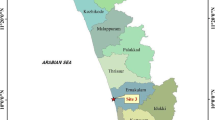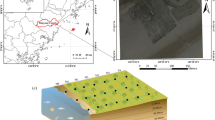Abstract
This work quantified the total carbon and 12 other sediment characteristics at 10 soil depths, in planted and or natural mangrove forests in comparison with non-vegetated soil for four seasons of the year 2009–2010 in the Vellar-Coleroon estuarine complex, India. The sediment characteristics varied significantly between mangrove-vegetated and non-vegetated habitats or seasons of analysis, but not between soil depths. The mangrove sediments were rich in total carbon and total organic carbon as compared to non-mangrove sediments (p <0.01). Total carbon was 98.2% higher in mature mangroves and 41.8% in planted mangroves than that in non-mangrove soil. Total organic carbon was as much as 2.5 times greater in mature mangroves and 2 times greater in planted mangroves than that in unvegetated soil. Carbon contents also varied many fold by season. Total carbon content was 8.6 times greater during pre-monsoon, 4.1 times greater during post-monsoon and 2.5 times greater during monsoon than during summer (p<0.01 in all cases). Similarly, total organic carbon was 5.9 times greater during pre-monsoon, 3.1 times greater during post-monsoon and 69% greater during monsoon than during summer. In general, higher levels of sediment carbon were recorded during pre and post-monsoon seasons than during other seasons. Total carbon concentration was correlated negatively to temperature, sand and phosphorus (p <0.01); positively correlated with redox potential, silt, clay, C/N ratio, potassium (p <0.01) and nitrogen (p <0.05); but not correlated with soil depth, pH or salinity. This work revealed that the carbon burial was rapid at the annual rate of 2.8% for total carbon, and 6.7% for total organic carbon in mangrove-planted sediment. Clearing of mangroves can result in significantly and rapidly reduced carbon stores. Our study highlights the importance of natural and plantation mangrove stands for conserving sediment carbon in the tropical coastal domain.
Similar content being viewed by others
References
Alongi DM, 1998. Coastal ecosystem processes. Available at: http://books.google.co.in/books?id=cMQp7bIZOogC.
Alongi DM, 2002. Present state and future of the world’s mangrove forests. Environment Conservation, 29:331–349.
Alongi DM, Ramanathan AL, Kannan L, Tirendi F, Trott LA, BalaKrishna Prasad M. 2005. Influence of human-induced disturbance on benthic microbial metabolism in the Pichavaram mangroves, Vellar-Coleroon estuarine complex, India. Marine Biology, 147: 1033–1044.
Alongi DM, Sasekumar A, Chong VC, Pfitzner J, Trott LA, Tirendi F, Dixon P, Brunskill GJ. 2004b. Sediment accumulation and organic material flux in a managed mangrove ecosystem: estimates of land-ocean-atmosphere exchange in peninsular Malaysia. Marine Geology, 208: 383–402.
Alongi DM, Sasekumar A, Tirendi F, Dixon P. 1998. The influence of stand age on nebthic decomposition and recycling of organic matter in managed mangrove forests of Malaysia. Journal of Experimental Marine Biology and Ecology, 225: 197–218.
Alongi DM, Tirendi F, Trott LA, Xuan XX. 2000. Benthic decomposition rates and pathways in plantation of the mangrove, Rhizophora apiculata, in the Mekong delta, Vietnam. Marine Ecology Progress Series, 194: 87–101.
Alongi DM, Wattayakorn G, Tirendi F, Dixon P. 2004a. Nutrient capital in different aged forests of the mangrove Rhizophora apiculata. Botanica Marina, 47: 116–124.
Bordovskiy OK. 1965. Accumulation and transformation of organic substances in marine sediments. Marine Geology, 3: 3–114.
Boto KG. 1992. Nutrients and mangroves. In: Connell, D.W., Hawker, D.W., (eds.), Pollution in Tropical Aquatic Systems. Boca Raton FL: CRC Press, pp. 129–145.
Bouillon S, Borges AV, Edward Castaneda-Moya, Karen Diele Dittmar T, Duke NC, Erik Krishtensen Lee SY, Cyril Marchand, Middelburg JJ, Rivera-Monroy VH, Smith III TJ, Twilley RR. 2009. Mangrove production and carbon sinks: A revision of global budget estimates. Global Biogeochemical Cycles, 22: 1–12.
Bouillon S, Connolly RM, Lee SY. 2008. Organic matter exchange and cycling in mangrove ecosystems: recent insights from stable isotope studies. Journal of Sea Research, 59: 44–58.
Bouillon S, Dahdouh-Guebas F, Rao AVVS, Koedam N, Dehairs F. 2003. Sources of organic carbon in mangrove sediments: variability and possible ecological implications. Hydrobiologia, 495: 33–39.
Bouillon S, Moens T, Overmeer I, Koedam N, Dehairs F. 2004. Resource utilization patterns of epifauna from mangrove forests with contrasting inputs of local versus imported organic matter. Marine Ecology Progress Series, 278: 77–88.
Buchanan JB. 1984. Sediment analysis. In: Holme, N.A., McIntyre, A.D., (Eds.), Methods for the Study of Marine Benthos. London: Blackwell Scientific Publications, pp. 41–65.
Chmura GL, Anisfeld SC, Cahoon DR, Lynch JC. 2003. Global carbon sequestration in tidal, saline wetland soils. Glob Biogeochem Cycles, 17(4): 1111, doi:10.1029/2002GB001917
Duarte CM, Cebrian J. 1996. The fate of marine autotrophic production. Limnology Oceanography, 41: 1758–1766.
Duarte CM, Middelburg JJ, Caraco N. 2005. Major role of marine vegetation on the oceanic carbon cycle. Biogeosciences, 2: 1–8.
El Wakeel SK, Riley JP. 1956. The determination of organic carbon in marine muds. Journal de conseil permanent Intl. Pourl exploration de la mer, 22: 180–183.
Fujimoto K, Imaya A, Tabuchi R, Kuramoto S, Utsugi H, Murofushi T. 1999. Belowground carbon storage of Micronesian mangrove forests. Ecology Reserves, 14: 409–413.
Gilman EL, Ellison J, Duke NC, Field C. 2008. Threats to mangroves from climate change and adaptation options: a review. Aquatic Botany, 89: 237–250.
Golterman HL. 2001. Phosphate release from anoxic sediments or ‘what did Mortimer really write?’ Hydrobiologia, 450: 99–106.
Guzman HM, Jimenez CE. 1992. Contamination of coral reefs by heavy metals along the Carribeen coast of central America (Coastal Rica and Panama). Marine Pollution Bulletin, 24(11): 554–561.
Hasrizal S, Kamaruzzaman BY, Sakri I, Ong MC, Noor Azhar MS. 2009 Seasonal Distribution of Organic Carbon in the Surface Sediments of the Terengganu Near shore Coastal Area. American Journal of Environmental Sciences, 5(1): 111–115.
Kathiresan K, Bingham BL. 2001. Biology of mangroves and mangrove ecosystems. Advances in Marine Biology 40: 81–251.
Kathiresan K. 2000. A review of studies on Pichavaram mangroves, southeast India. Hydrobiologia, 430: 185–205.
Kennedy H, Gaciab E, Kennedya S, Papdimitrioua DP, Duarte CM. 2004. Organic carbon sources to SE Asian coastal sediments. Estuarine Coastal and Shelf Science, 60: 59–68.
Komiyama A, Ong JE, Poungparn S. 2008. Allometry, biomass and productivity of mangrove forests: A review. Aquatic Botany, 89: 128–137.
Kristensen E, Bouillon S, Dittmar T, Marchand C. 2008. Organic carbon dynamics in mangrove ecosystems: a review. Aquatic Botany, 89: 201–219.
Lallier-Verges E, Perrussel BP, Disnar JR, Baltzer F. 1998. Relationships between environmental conditions and the diagenetic evolution of organic matter derived from higher plants a modern mangrove swamp systems (Guadeloupe, French West Indies). Organic Geochemistry, 29: 1663–1686.
Matsui N. 1998. Estimated stocks of organic carbon in mangrove roots and sediments in Hinchinbrook Channek, Australia. Mangroves and Salt Marshes, 2: 199–204.
Meyers PA. 1994. Preservation of elemental and isotopic source identification of sedimentary organic matter. Chemical Geology, 144: 289–302.
Muller A, Voss M. 1999. The Palaeoenvironments of coastal lagoons in the southern Baltic Sea II. δ13C and δ15N ratios of organic matter-sources and sediments. Palaeoecology, 145: 17–32.
Ong JE. 1993. Mangroves — a carbon source and sink. Chemosphere, 27: 1097–1107.
Oxmann JF, Luitgard Schwendenmann Ruben J Lara. 2009. Interactions among phosphorus, pH and Eh in reforested mangroves, Vietnam: a three-dimensional spatial analysis. Biogeochemistry, 96: 73–85.
Oxmann JF, Pham QH, Schwendenmann L, Stellman JM, Lara RJ. 2010. Mangrove reforestation in Vietnam: the effect of sediment physicochemical properties on nutrient cycling. Plant Soil, 326: 225–241.
Ramanathan AL. 1997. Sediment characteristics of the Pichavaram mangrove environment, south east coast of India. Indian Journal of Marine Science, 26: 319–322.
Subbiah BV, Asija GL. 1956. A rapid procedure for the determination of available nitrogen in soils. Current Science, 31: 196–200.
Volkman JK, Rohjans D, Rullkotter J, Scholz-Bottcher BM, Liebezeit G. 2000. Sources and diagenesis of organic matter in tidal flat sediments from the German Wadden Sea. Continental Shelf Research, 20: 1139–1158.
Xue B. Yan CL, Lu HL, Bai Y. 2009. Mangrove-Derived organic carbon in sediment from Zhangjiang estuary (China) mangrove wetland. Journal of Coastal Research, 25(4): 949–956.
Author information
Authors and Affiliations
Corresponding authors
Rights and permissions
About this article
Cite this article
Kathiresan, K., Gomathi, V., Anburaj, R. et al. Impact of mangrove vegetation on seasonal carbon burial and other sediment characteristics in the Vellar-Coleroon estuary, India. Journal of Forestry Research 25, 787–794 (2014). https://doi.org/10.1007/s11676-014-0526-2
Received:
Accepted:
Published:
Issue Date:
DOI: https://doi.org/10.1007/s11676-014-0526-2




